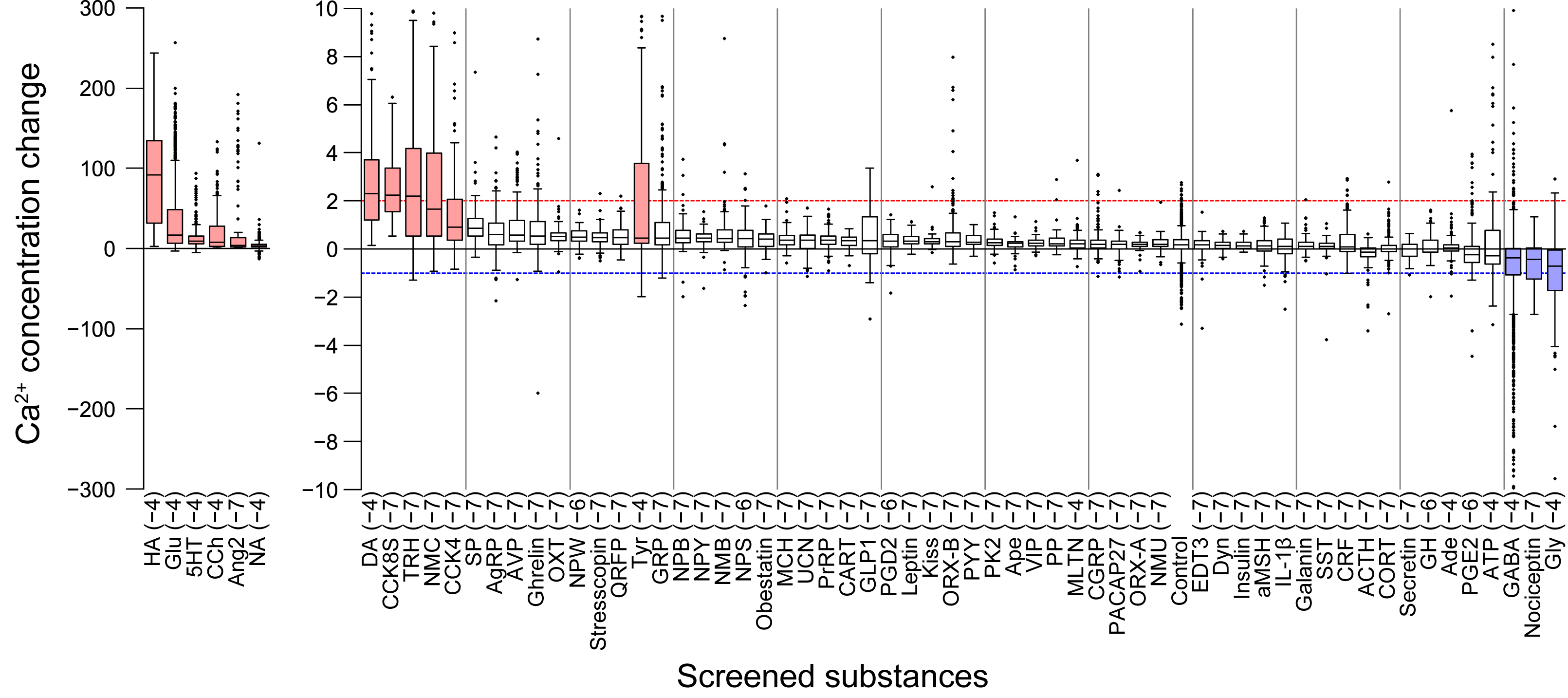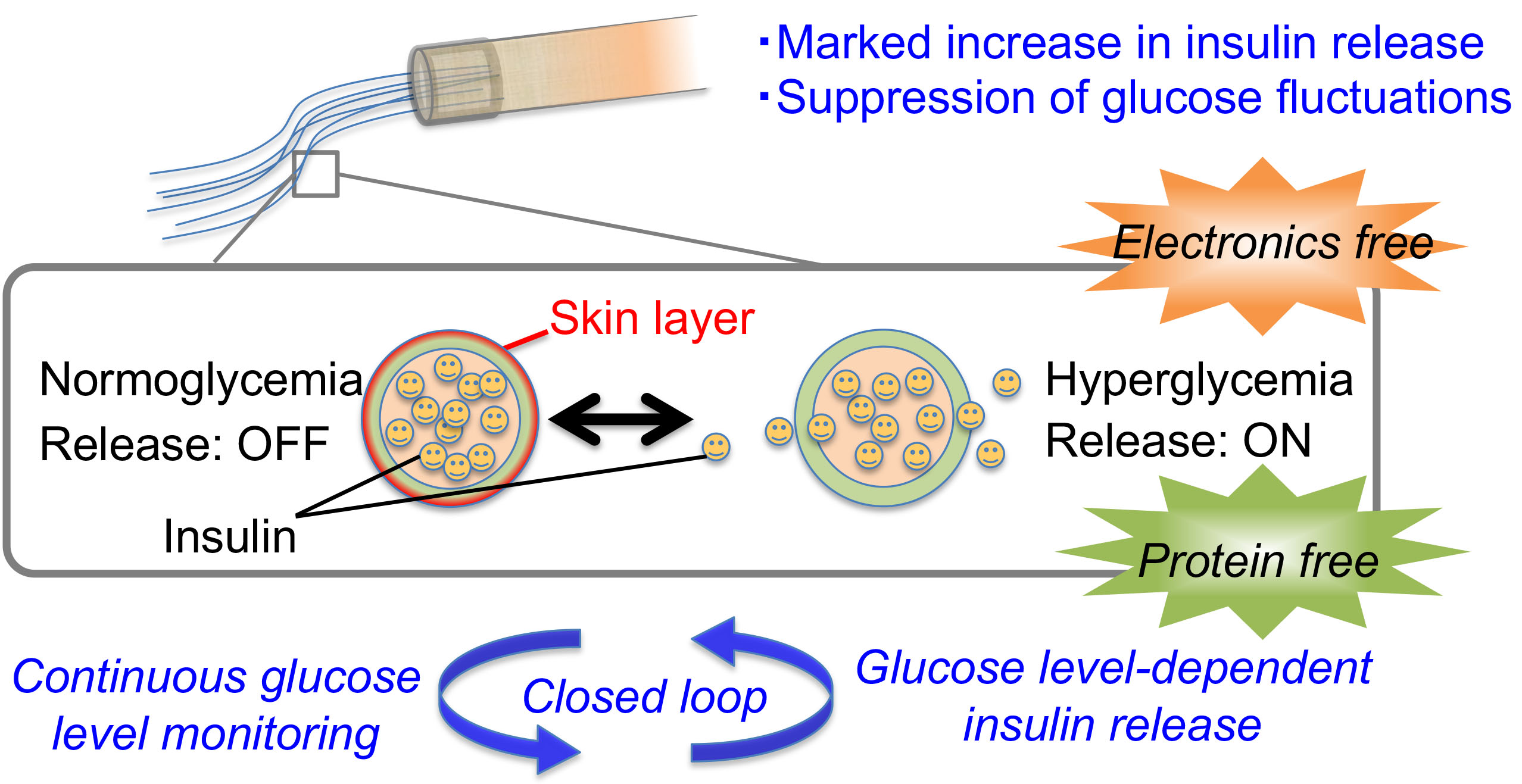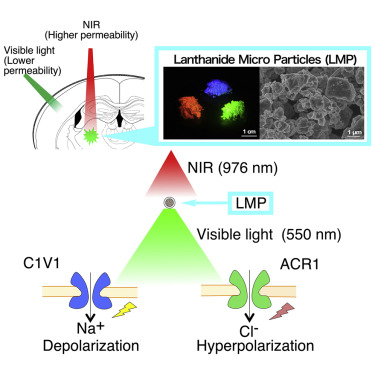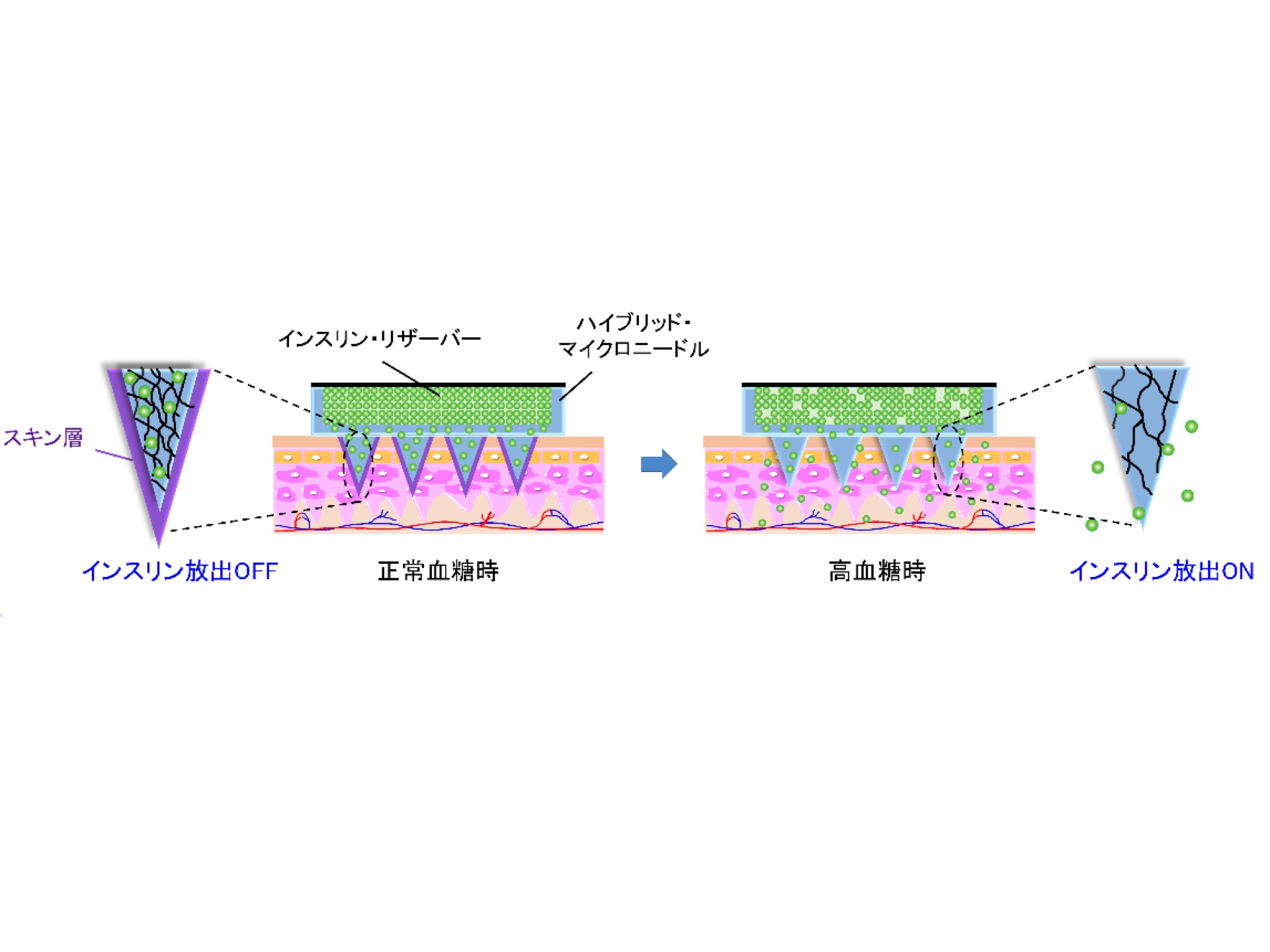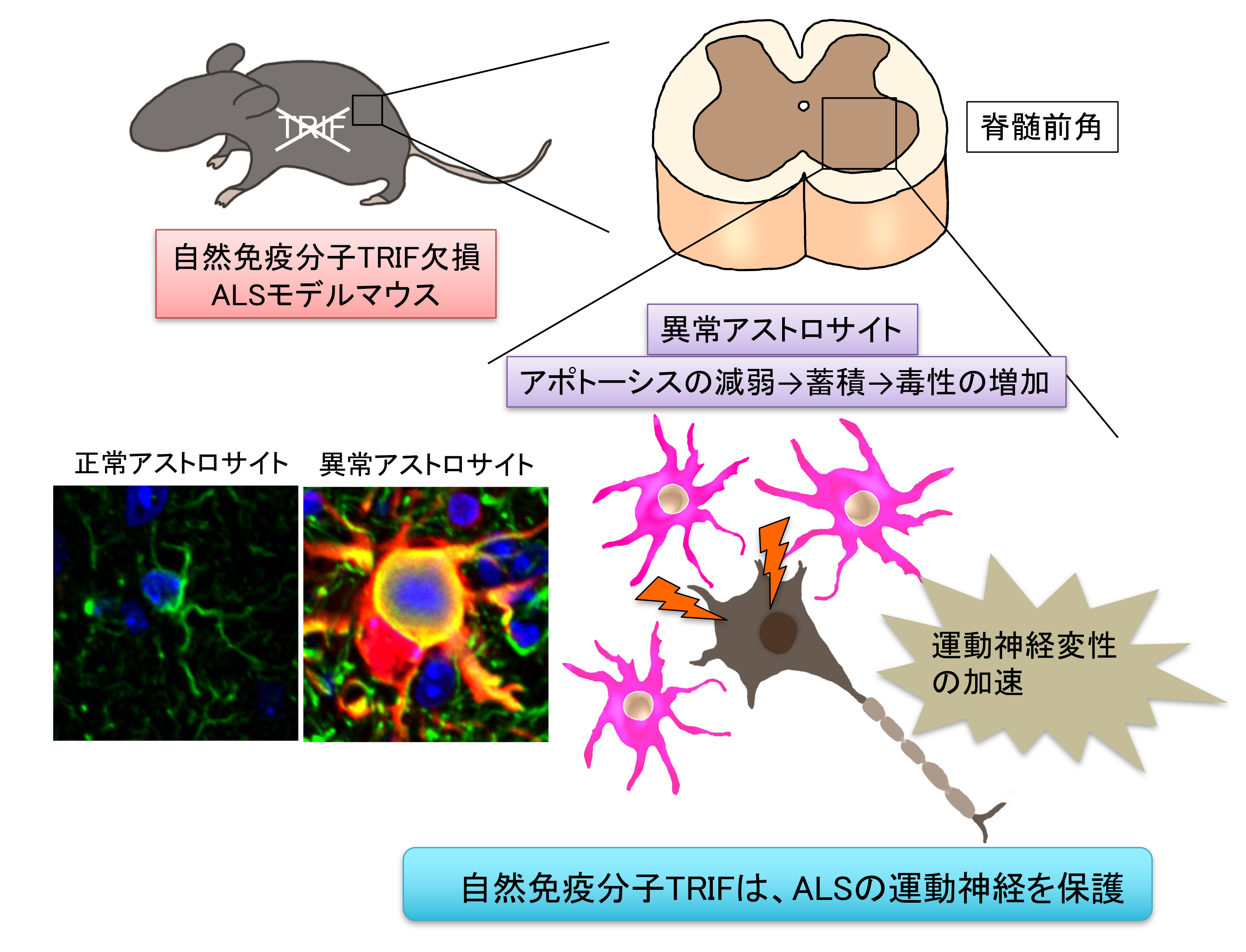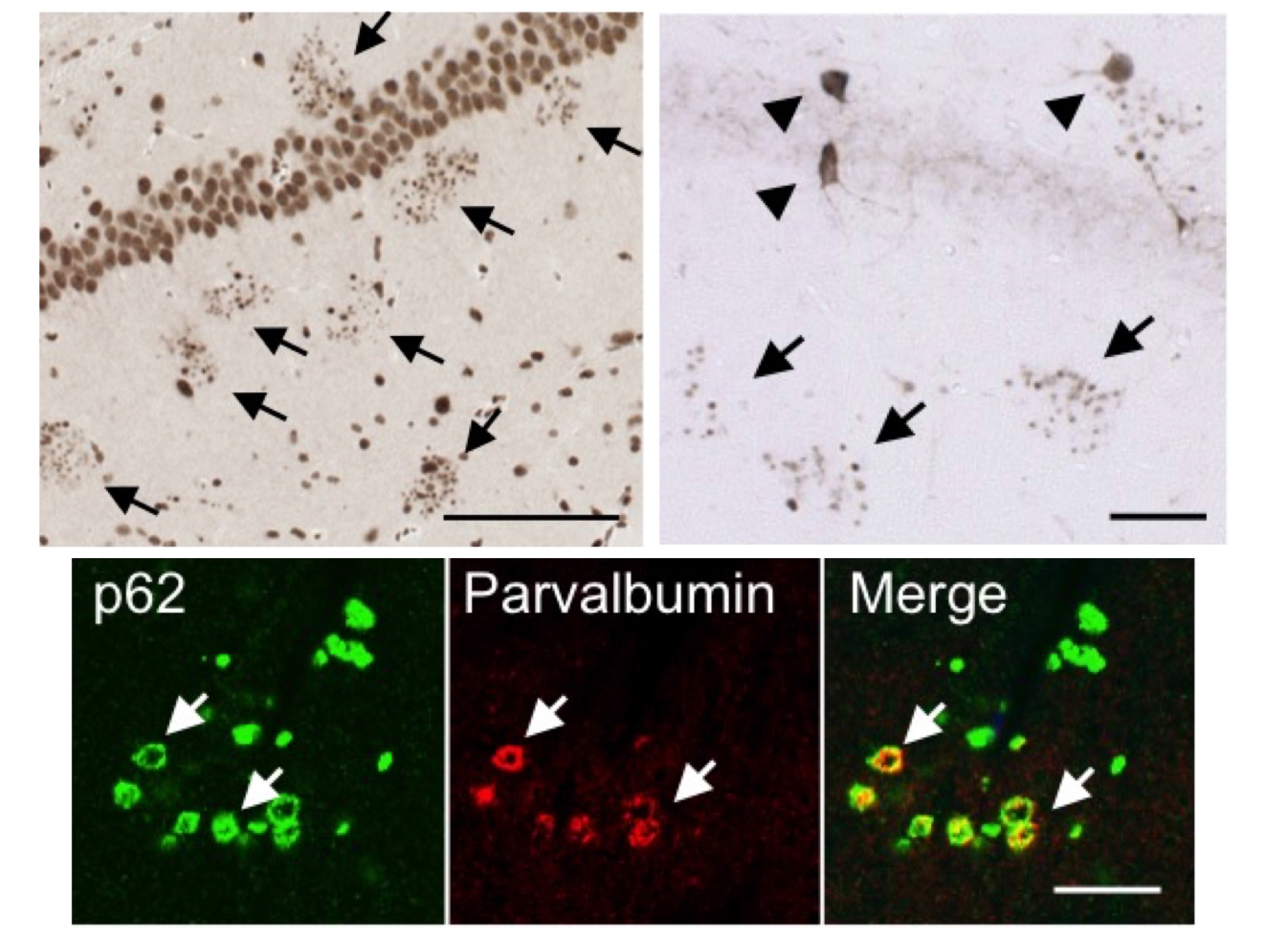Press Release Update
2024.4.10
A team of researchers including Yasuyoshi Oka, Yuka Nakazawa, Mayuko Shimada, and Tomoo Ogi at Research Institute of Environmental Medicine has discovered that aldehydes are metabolic byproducts associated with premature aging.
A team of researchers including Yasuyoshi Oka, Yuka Nakazawa, Mayuko Shimada, and Tomoo Ogi at Research Institute of Environmental Medicine has discovered that aldehydes are metabolic byproducts associated with premature aging.
Press Release Update
2024.2.1
Lecturer Okiru Komine and Prof. Koji Yamanaka (Department of Neuroscience and Pathobiology, RIEM / Nagoya University Graduate School of Medicine) found that genetic background variation impacts microglial heterogeneity, especially disease-associated microglia (DAM), to affect the disease progression in ALS.
Lecturer Okiru Komine and Prof. Koji Yamanaka (Department of Neuroscience and Pathobiology, RIEM / Nagoya University Graduate School of Medicine) found that genetic background variation impacts microglial heterogeneity, especially disease-associated microglia (DAM), to affect the disease progression in ALS.
Press Release Update
2024.2.1
Lecturer Seiji Watanabe and Prof. Koji Yamanaka (Department of Neuroscience and Pathobiology, RIEM / Nagoya University Graduate School of Medicine) have identified that disruption of the mitochondria-associated membranes (MAM) in amyotrophic lateral sclerosis (ALS) causes a reduction in the activity of TANK-binding kinase 1 (TBK1), leading to an abnormal stress response in motor neurons.
Lecturer Seiji Watanabe and Prof. Koji Yamanaka (Department of Neuroscience and Pathobiology, RIEM / Nagoya University Graduate School of Medicine) have identified that disruption of the mitochondria-associated membranes (MAM) in amyotrophic lateral sclerosis (ALS) causes a reduction in the activity of TANK-binding kinase 1 (TBK1), leading to an abnormal stress response in motor neurons.
Press Release Update
2023.9.20
Researcher Assoc. Prof. Michiko Itoh and Prof. Takayoshi Suganami (Department of Molecular Medicine and Metabolism, RIEM / Nagoya University) revealed the pathomechanism of non-alcoholic steatohepatitis by focusing on cholesterol accumulation in macrophages, and proposed a novel therapeutic strategy by means of medical-engineering collaboration.
Researcher Assoc. Prof. Michiko Itoh and Prof. Takayoshi Suganami (Department of Molecular Medicine and Metabolism, RIEM / Nagoya University) revealed the pathomechanism of non-alcoholic steatohepatitis by focusing on cholesterol accumulation in macrophages, and proposed a novel therapeutic strategy by means of medical-engineering collaboration.
Press Release Update
2023.8.29
Researcher Kotaro Oiwa and Prof. Koji Yamanaka (Department of Neuroscience and Pathobiology, RIEM / Nagoya University Graduate School of Medicine) found that TDP-43 monomerization is a key determinant of TDP-43 pathology in ALS.
Researcher Kotaro Oiwa and Prof. Koji Yamanaka (Department of Neuroscience and Pathobiology, RIEM / Nagoya University Graduate School of Medicine) found that TDP-43 monomerization is a key determinant of TDP-43 pathology in ALS.
Press Release Update
2023.1.5
The research team led by Dr. Daisuke Ono of Graduate School of Medicine, Nagoya University, collaborating with Yulong Li of Peking University and Takashi Sugiyama of Evident Corporation found that circadian rhythms of intracellular cAMP in the SCN are regulated by neuropeptide-related neural networks.
The research team led by Dr. Daisuke Ono of Graduate School of Medicine, Nagoya University, collaborating with Yulong Li of Peking University and Takashi Sugiyama of Evident Corporation found that circadian rhythms of intracellular cAMP in the SCN are regulated by neuropeptide-related neural networks.
Press Release Update
2021.6.13
Assistant Prof. Akira Sobue and Prof. Koji Yamanaka (Department of Neuroscience and Pathobiology, RIEM / Nagoya University Graduate School of Medicine) found that microglial gene signature reveals loss of homeostatic microglia as a key event for driving neurodegeneration of Alzheimer's disease.
Assistant Prof. Akira Sobue and Prof. Koji Yamanaka (Department of Neuroscience and Pathobiology, RIEM / Nagoya University Graduate School of Medicine) found that microglial gene signature reveals loss of homeostatic microglia as a key event for driving neurodegeneration of Alzheimer's disease.
Press Release Update
2021.1.20
Researchers led by our faculty (Prof. Takayoshi Suganami, Assist. Prof. Miyako Tanaka, and Dr. Yohei Kanamori, Department of Molecular Medicine and Metabolism) revealed that iron-rich Kupffer cells exhibit phenotypic changes during the development of liver fibrosis in non nonalcoholic steatohepatitis.
Researchers led by our faculty (Prof. Takayoshi Suganami, Assist. Prof. Miyako Tanaka, and Dr. Yohei Kanamori, Department of Molecular Medicine and Metabolism) revealed that iron-rich Kupffer cells exhibit phenotypic changes during the development of liver fibrosis in non nonalcoholic steatohepatitis.
Press Release Update
2020.9.2
Researchers led by our faculty (Prof. Akihiro Yamanaka, Department of Neuroscience II) developed a screening method to identify factors regulating neurons important in stress response.
Researchers led by our faculty (Prof. Akihiro Yamanaka, Department of Neuroscience II) developed a screening method to identify factors regulating neurons important in stress response.
Press Release Update
2020.6.17
Researchers led by our faculty (Prof. Takayoshi Suganami, Assist. Prof. Miyako Tanaka, and Project Assist. Prof. Shinichiro Kimura, Department of Molecular Medicine and Metabolism) developed a hollow fiber–combined glucose responsive gel technology as an in vivo electronics-free insulin delivery system.
Researchers led by our faculty (Prof. Takayoshi Suganami, Assist. Prof. Miyako Tanaka, and Project Assist. Prof. Shinichiro Kimura, Department of Molecular Medicine and Metabolism) developed a hollow fiber–combined glucose responsive gel technology as an in vivo electronics-free insulin delivery system.
Upcoming Special Lecture Tokuron
2019.7.19
Luis de Lecea, Ph D.(Professor, Department of Psychiatry and Behavioral Sciences, Stanford University)
"Developmental Aspects of Sleep and Wakefulness"
Aug. 1st. 2019(Thu.)17:00-18:30 @RIEM, North Building, N201 (Higashiyama Campus)
"Developmental Aspects of Sleep and Wakefulness"
Aug. 1st. 2019(Thu.)17:00-18:30 @RIEM, North Building, N201 (Higashiyama Campus)
Luis de Lecea, Ph D.(Professor, Department of Psychiatry and Behavioral Sciences, Stanford University)
"Developmental Aspects of Sleep and Wakefulness"
Aug. 1st. 2019(Thu.)17:00-18:30 @RIEM, North Building, N201 (Higashiyama Campus)
»Details
Aug. 1st. 2019(Thu.)17:00-18:30 @RIEM, North Building, N201 (Higashiyama Campus)
»Details
Press Release Update
2020.9.2
Researchers led by our faculty (Prof. Akihiro Yamanaka, Department of Neuroscience II) developed a screening method to identify factors regulating neurons important in stress response.
Researchers led by our faculty (Prof. Akihiro Yamanaka, Department of Neuroscience II) developed a screening method to identify factors regulating neurons important in stress response.
Press Release Update
2019.1.22
Researchers led by our faculty (Prof. Akihiro Yamanaka and Associate Prof. Takayuki Yamashita, Department of Neuroscience II) developed a technique to manipulate activities of specific neuronal populations in freely moving animals without insertion of optic fibers.
Researchers led by our faculty (Prof. Akihiro Yamanaka and Associate Prof. Takayuki Yamashita, Department of Neuroscience II) developed a technique to manipulate activities of specific neuronal populations in freely moving animals without insertion of optic fibers.
Press Release Update
2019.1.21
Researchers led by our faculty (Prof. Takayoshi Suganami and Assist. Prof. Miyako Tanaka, Department of Molecular Medicine and Metabolism) developed a microneedle‐array patch-based “closed‐loop” artificial pancreas that is “electronics-free”, “enzyme-free” and “nanoparticle-free”.
Researchers led by our faculty (Prof. Takayoshi Suganami and Assist. Prof. Miyako Tanaka, Department of Molecular Medicine and Metabolism) developed a microneedle‐array patch-based “closed‐loop” artificial pancreas that is “electronics-free”, “enzyme-free” and “nanoparticle-free”.
Upcoming Special Lecture Tokuron
2018.7.20
Lecture 1
Thomas S. Kilduff, Ph D.(Center Director, Center for Neuroscience, SRI International)
"Cortical nNOS/NK1R Neurons: Orchestrators of EEG Slow Wave Activity?"
Lecture 2
Bilal Haider, Ph D.(Assistant Professor, Biomedical Engineering, Georgia Tech & Emory University)
"Cortical state control of visual perception"
Jul. 30th. 2018(Monday)13:30-15:00 (Lecture 1), 15:00-16:30 (Lecture 2) @RIEM, South Building, S204 (Higashiyama Campus)
Thomas S. Kilduff, Ph D.(Center Director, Center for Neuroscience, SRI International)
"Cortical nNOS/NK1R Neurons: Orchestrators of EEG Slow Wave Activity?"
Lecture 2
Bilal Haider, Ph D.(Assistant Professor, Biomedical Engineering, Georgia Tech & Emory University)
"Cortical state control of visual perception"
Jul. 30th. 2018(Monday)13:30-15:00 (Lecture 1), 15:00-16:30 (Lecture 2) @RIEM, South Building, S204 (Higashiyama Campus)
Lecturer 1: Thomas S. Kilduff, Ph D.(Center Director, Center for Neuroscience, SRI International)
"Cortical nNOS/NK1R Neurons: Orchestrators of EEG Slow Wave Activity?"
Lecture 2: Bilal Haider, Ph D.(Assistant Professor, Biomedical Engineering, Georgia Tech & Emory University) "Cortical state control of visual perception"
Jul. 30th. 2018(Monday)13:30-15:00 (Lecture 1), 15:00-16:30 (Lecture 2) @RIEM, South Building, S204 (Higashiyama Campus)
»Details
Lecture 2: Bilal Haider, Ph D.(Assistant Professor, Biomedical Engineering, Georgia Tech & Emory University) "Cortical state control of visual perception"
Jul. 30th. 2018(Monday)13:30-15:00 (Lecture 1), 15:00-16:30 (Lecture 2) @RIEM, South Building, S204 (Higashiyama Campus)
»Details
Press Release Update
2018.4.17
Researchers led by our faculty (Prof. Koji Yamanaka, Department of Neuroscience and Pathobiology) revealed that deficiency of the innate immune adaptor TRIF significantly shortened survival time of ALS mice.
Researchers led by our faculty (Prof. Koji Yamanaka, Department of Neuroscience and Pathobiology) revealed that deficiency of the innate immune adaptor TRIF significantly shortened survival time of ALS mice.
Press Release Update
2017.12.13
A collaborative research group led by our faculty (Prof. Koji Yamanaka, Department of Neuroscience and Pathobiology) developed a new mouse model that captures pathology of sporadic neurological diseases.
A collaborative research group led by our faculty (Prof. Koji Yamanaka, Department of Neuroscience and Pathobiology) developed a new mouse model that captures pathology of sporadic neurological diseases.
Paper Published
2024.4.10
A team of researchers including Yasuyoshi Oka, Yuka Nakazawa, Mayuko Shimada, and Tomoo Ogi at Research Institute of Environmental Medicine has discovered that aldehydes are metabolic byproducts associated with premature aging.
A team of researchers including Yasuyoshi Oka, Yuka Nakazawa, Mayuko Shimada, and Tomoo Ogi at Research Institute of Environmental Medicine has discovered that aldehydes are metabolic byproducts associated with premature aging.
Paper Published
2024.2.1
Lecturer Okiru Komine and Prof. Koji Yamanaka (Department of Neuroscience and Pathobiology, RIEM / Nagoya University Graduate School of Medicine) found that genetic background variation impacts microglial heterogeneity, especially disease-associated microglia (DAM), to affect the disease progression in ALS.
Lecturer Okiru Komine and Prof. Koji Yamanaka (Department of Neuroscience and Pathobiology, RIEM / Nagoya University Graduate School of Medicine) found that genetic background variation impacts microglial heterogeneity, especially disease-associated microglia (DAM), to affect the disease progression in ALS.
Paper Published
2024.2.1
Lecturer Seiji Watanabe and Prof. Koji Yamanaka (Department of Neuroscience and Pathobiology, RIEM / Nagoya University Graduate School of Medicine) have identified that disruption of the mitochondria-associated membranes (MAM) in amyotrophic lateral sclerosis (ALS) causes a reduction in the activity of TANK-binding kinase 1 (TBK1), leading to an abnormal stress response in motor neurons.
Lecturer Seiji Watanabe and Prof. Koji Yamanaka (Department of Neuroscience and Pathobiology, RIEM / Nagoya University Graduate School of Medicine) have identified that disruption of the mitochondria-associated membranes (MAM) in amyotrophic lateral sclerosis (ALS) causes a reduction in the activity of TANK-binding kinase 1 (TBK1), leading to an abnormal stress response in motor neurons.
Paper Published
2023.9.20
Researcher Assoc. Prof. Michiko Itoh and Prof. Takayoshi Suganami (Department of Molecular Medicine and Metabolism, RIEM / Nagoya University) revealed the pathomechanism of non-alcoholic steatohepatitis by focusing on cholesterol accumulation in macrophages, and proposed a novel therapeutic strategy by means of medical-engineering collaboration.
Researcher Assoc. Prof. Michiko Itoh and Prof. Takayoshi Suganami (Department of Molecular Medicine and Metabolism, RIEM / Nagoya University) revealed the pathomechanism of non-alcoholic steatohepatitis by focusing on cholesterol accumulation in macrophages, and proposed a novel therapeutic strategy by means of medical-engineering collaboration.
Paper Published
2023.8.29
Researcher Kotaro Oiwa and Prof. Koji Yamanaka (Department of Neuroscience and Pathobiology, RIEM / Nagoya University Graduate School of Medicine) found that TDP-43 monomerization is a key determinant of TDP-43 pathology in ALS.
Researcher Kotaro Oiwa and Prof. Koji Yamanaka (Department of Neuroscience and Pathobiology, RIEM / Nagoya University Graduate School of Medicine) found that TDP-43 monomerization is a key determinant of TDP-43 pathology in ALS.
Paper Published
2023.1.5
The research team led by Dr. Daisuke Ono of Graduate School of Medicine, Nagoya University, collaborating with Yulong Li of Peking University and Takashi Sugiyama of Evident Corporation found that circadian rhythms of intracellular cAMP in the SCN are regulated by neuropeptide-related neural networks.
The research team led by Dr. Daisuke Ono of Graduate School of Medicine, Nagoya University, collaborating with Yulong Li of Peking University and Takashi Sugiyama of Evident Corporation found that circadian rhythms of intracellular cAMP in the SCN are regulated by neuropeptide-related neural networks.
Paper Published
2021.6.13
Assistant Prof. Akira Sobue and Prof. Koji Yamanaka (Department of Neuroscience and Pathobiology, RIEM / Nagoya University Graduate School of Medicine) found that microglial gene signature reveals loss of homeostatic microglia as a key event for driving neurodegeneration of Alzheimer's disease.
Assistant Prof. Akira Sobue and Prof. Koji Yamanaka (Department of Neuroscience and Pathobiology, RIEM / Nagoya University Graduate School of Medicine) found that microglial gene signature reveals loss of homeostatic microglia as a key event for driving neurodegeneration of Alzheimer's disease.
Paper Published
2021.1.20
Researchers led by our faculty (Prof. Takayoshi Suganami, Assist. Prof. Miyako Tanaka, and Dr. Yohei Kanamori, Department of Molecular Medicine and Metabolism) revealed that iron-rich Kupffer cells exhibit phenotypic changes during the development of liver fibrosis in non nonalcoholic steatohepatitis.
Researchers led by our faculty (Prof. Takayoshi Suganami, Assist. Prof. Miyako Tanaka, and Dr. Yohei Kanamori, Department of Molecular Medicine and Metabolism) revealed that iron-rich Kupffer cells exhibit phenotypic changes during the development of liver fibrosis in non nonalcoholic steatohepatitis.
Paper Published
2020.9.2
Researchers led by our faculty (Prof. Akihiro Yamanaka, Department of Neuroscience II) developed a screening method to identify factors regulating neurons important in stress response.
Researchers led by our faculty (Prof. Akihiro Yamanaka, Department of Neuroscience II) developed a screening method to identify factors regulating neurons important in stress response.
Paper Published
2020.6.17
Researchers led by our faculty (Prof. Takayoshi Suganami, Assist. Prof. Miyako Tanaka, and Project Assist. Prof. Shinichiro Kimura, Department of Molecular Medicine and Metabolism) developed a hollow fiber–combined glucose responsive gel technology as an in vivo electronics-free insulin delivery system.
Researchers led by our faculty (Prof. Takayoshi Suganami, Assist. Prof. Miyako Tanaka, and Project Assist. Prof. Shinichiro Kimura, Department of Molecular Medicine and Metabolism) developed a hollow fiber–combined glucose responsive gel technology as an in vivo electronics-free insulin delivery system.
Paper Published
2019.1.21
Researchers led by our faculty (Prof. Akihiro Yamanaka and Associate Prof. Takayuki Yamashita, Department of Neuroscience II) developed a technique to manipulate activities of specific neuronal populations in freely moving animals without insertion of optic fibers.
Researchers led by our faculty (Prof. Akihiro Yamanaka and Associate Prof. Takayuki Yamashita, Department of Neuroscience II) developed a technique to manipulate activities of specific neuronal populations in freely moving animals without insertion of optic fibers.
Paper Published
2019.1.21
Researchers led by our faculty (Prof. Takayoshi Suganami and Assist. Prof. Miyako Tanaka, Department of Molecular Medicine and Metabolism) developed a microneedle‐array patch-based “closed‐loop” artificial pancreas that is “electronics-free”, “enzyme-free” and “nanoparticle-free”.
Researchers led by our faculty (Prof. Takayoshi Suganami and Assist. Prof. Miyako Tanaka, Department of Molecular Medicine and Metabolism) developed a microneedle‐array patch-based “closed‐loop” artificial pancreas that is “electronics-free”, “enzyme-free” and “nanoparticle-free”.
Paper Published
2018.4.17
Researchers led by our faculty (Prof. Koji Yamanaka, Department of Neuroscience and Pathobiology) revealed that deficiency of the innate immune adaptor TRIF significantly shortened survival time of ALS mice.
Upcoming Special Lecture Tokuron
2019.7.19
Luis de Lecea, Ph D.(Professor, Department of Psychiatry and Behavioral Sciences, Stanford University)
"Developmental Aspects of Sleep and Wakefulness"
Aug. 1st. 2019(Thu.)17:00-18:30 @RIEM, North Building, N201 (Higashiyama Campus)
"Developmental Aspects of Sleep and Wakefulness"
Aug. 1st. 2019(Thu.)17:00-18:30 @RIEM, North Building, N201 (Higashiyama Campus)
Luis de Lecea, Ph D.(Professor, Department of Psychiatry and Behavioral Sciences, Stanford University)
"Developmental Aspects of Sleep and Wakefulness"
Aug. 1st. 2019(Thu.)17:00-18:30 @RIEM, North Building, N201 (Higashiyama Campus)
»Details
Aug. 1st. 2019(Thu.)17:00-18:30 @RIEM, North Building, N201 (Higashiyama Campus)
»Details
Special Lecture Tokuron
2018.7.20
Lecture 1
Thomas S. Kilduff, Ph D.(Center Director, Center for Neuroscience, SRI International)
"Cortical nNOS/NK1R Neurons: Orchestrators of EEG Slow Wave Activity?"
Lecture 2
Bilal Haider, Ph D.(Assistant Professor, Biomedical Engineering, Georgia Tech & Emory University)
"Cortical state control of visual perception"
Jul. 30th. 2018(Monday)13:30-15:00 (Lecture 1), 15:00-16:30 (Lecture 2) @RIEM, South Building, S204 (Higashiyama Campus)
Thomas S. Kilduff, Ph D.(Center Director, Center for Neuroscience, SRI International)
"Cortical nNOS/NK1R Neurons: Orchestrators of EEG Slow Wave Activity?"
Lecture 2
Bilal Haider, Ph D.(Assistant Professor, Biomedical Engineering, Georgia Tech & Emory University)
"Cortical state control of visual perception"
Jul. 30th. 2018(Monday)13:30-15:00 (Lecture 1), 15:00-16:30 (Lecture 2) @RIEM, South Building, S204 (Higashiyama Campus)
Lecturer 1: Thomas S. Kilduff, Ph D.(Center Director, Center for Neuroscience, SRI International)
"Cortical nNOS/NK1R Neurons: Orchestrators of EEG Slow Wave Activity?"
Lecture 2: Bilal Haider, Ph D.(Assistant Professor, Biomedical Engineering, Georgia Tech & Emory University) "Cortical state control of visual perception"
Jul. 30th. 2018(Monday)13:30-15:00 (Lecture 1), 15:00-16:30 (Lecture 2) @RIEM, South Building, S204 (Higashiyama Campus)
»Details
Lecture 2: Bilal Haider, Ph D.(Assistant Professor, Biomedical Engineering, Georgia Tech & Emory University) "Cortical state control of visual perception"
Jul. 30th. 2018(Monday)13:30-15:00 (Lecture 1), 15:00-16:30 (Lecture 2) @RIEM, South Building, S204 (Higashiyama Campus)
»Details

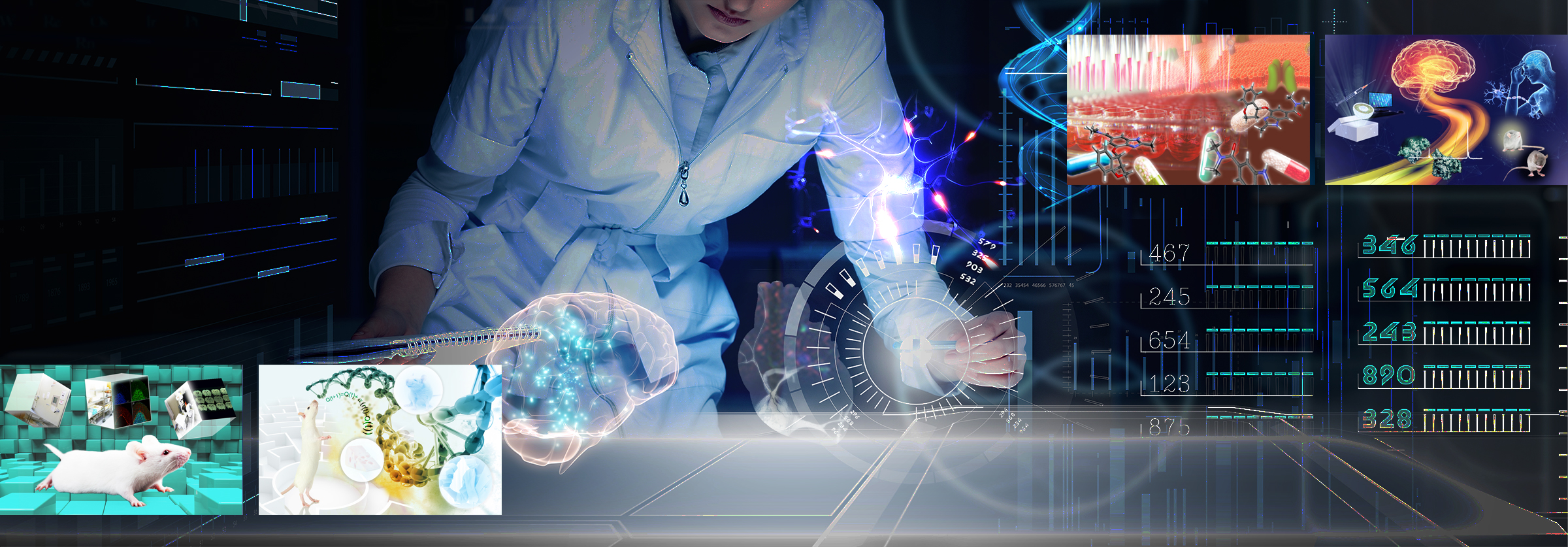


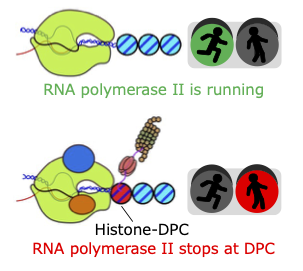
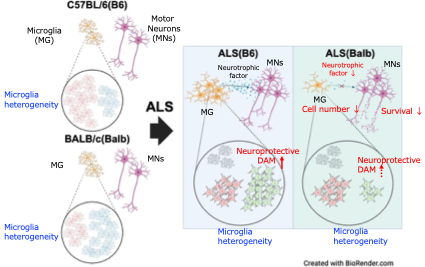
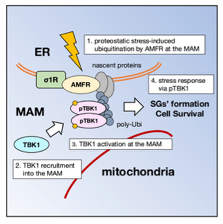
.png)
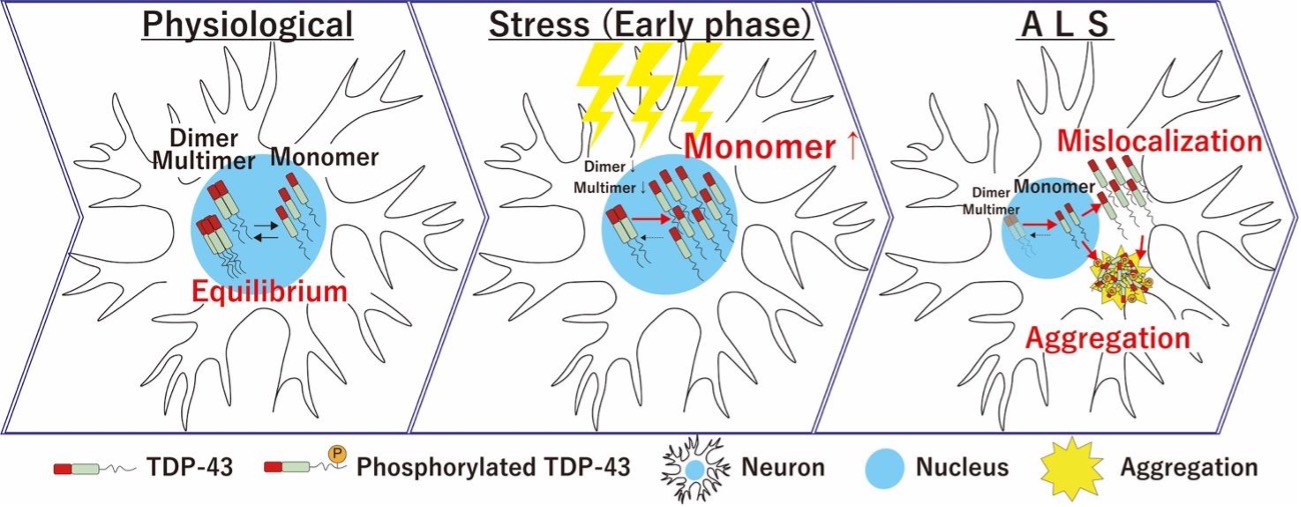
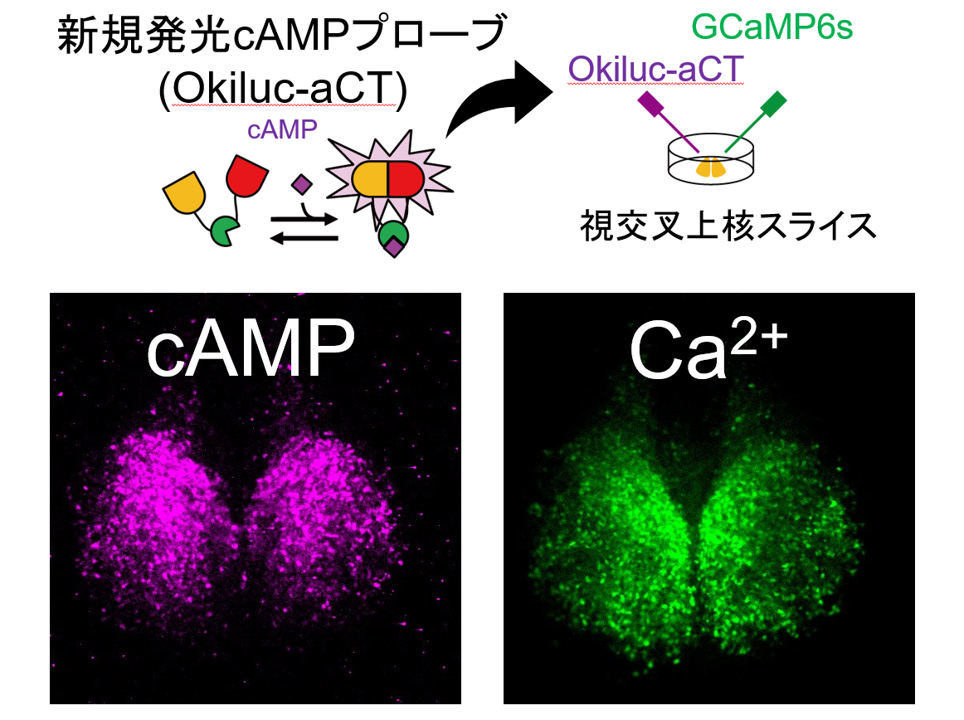
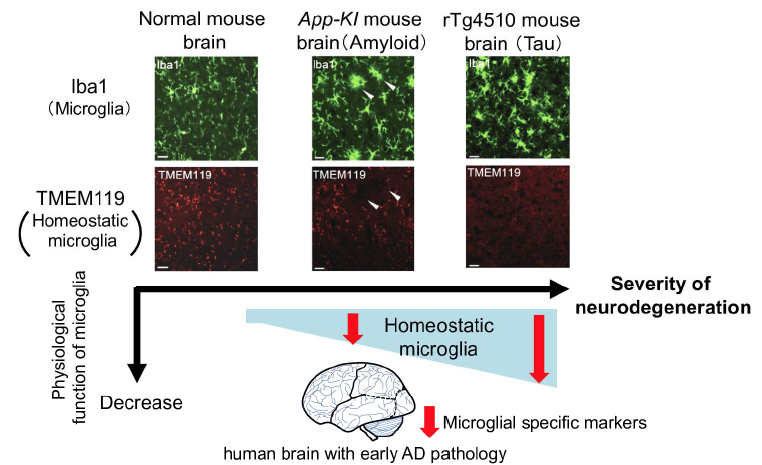
.jpg)
